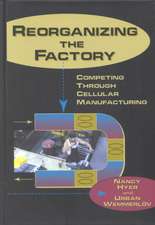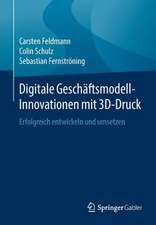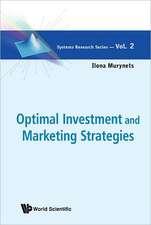Quality, Involvement, Flow: The Systemic Organization
Autor Domenico Lepore, Angela Montgomery, Giovanni Siepeen Limba Engleză Paperback – 18 aug 2016
| Toate formatele și edițiile | Preț | Express |
|---|---|---|
| Paperback (1) | 273.27 lei 6-8 săpt. | |
| Taylor & Francis – 18 aug 2016 | 273.27 lei 6-8 săpt. | |
| Hardback (1) | 986.91 lei 6-8 săpt. | |
| Taylor & Francis – 15 aug 2017 | 986.91 lei 6-8 săpt. |
Preț: 273.27 lei
Preț vechi: 334.44 lei
-18% Nou
Puncte Express: 410
Preț estimativ în valută:
52.30€ • 54.40$ • 43.17£
52.30€ • 54.40$ • 43.17£
Carte tipărită la comandă
Livrare economică 14-28 aprilie
Preluare comenzi: 021 569.72.76
Specificații
ISBN-13: 9781498755887
ISBN-10: 1498755887
Pagini: 256
Ilustrații: 96
Dimensiuni: 178 x 254 x 24 mm
Greutate: 0.49 kg
Ediția:1
Editura: Taylor & Francis
Colecția Productivity Press
Locul publicării:Oxford, United Kingdom
ISBN-10: 1498755887
Pagini: 256
Ilustrații: 96
Dimensiuni: 178 x 254 x 24 mm
Greutate: 0.49 kg
Ediția:1
Editura: Taylor & Francis
Colecția Productivity Press
Locul publicării:Oxford, United Kingdom
Public țintă
Professional Practice & DevelopmentCuprins
1. Navigating the New Complexity...................................................1
in a Practical Way?......................................................................37
the New Organization.................................................................61
and Improving the System..........................................................85
The Inherent Conflict of Change................................................99
Foster a New Systemic Intelligence..........................................109
(So They Can Manage Systemically Without Being Experts in Everything)..........151
1.1 Dividing Things Up Is No Longer the Answer..................................22. Why Are We Stuck? The Inherent Conflict of Organizations.....11
1.2 Useful Lessons from Science: From Parts to Whole...........................3
1.3 The Organization: A Whole That Is Much More Than the
Sum of Its Parts...................................................................................4
1.4 New Leadership...................................................................................5
1.5 What Is a Leader?................................................................................6
1.6 Leadership and Knowledge................................................................6
1.7 Leadership and Selflessness................................................................7
1.8 Quality, Involvement, Flow.................................................................8
1.9 Leadership Thinking: Framing the Change as a Conflict..................9
2.1 What’s Wrong with a Hierarchy?.......................................................123. Where Does the Knowledge to Move Forward Come From?
2.2 The Silo Sickness...............................................................................12
2.3 The Inherent Conflict in Any Organization.....................................14
2.4 Finding a Solution to the Hierarchy Conflict....................................17
2.5 A New Kind of Organization: Coordination Instead of
Functional Reporting.........................................................................19
2.6 The Challenge of the Solution to the Hierarchy Conflict................20
The Giant Contributions of Dr. Deming and Dr. Goldratt..........234. What Is an Organization? The Fundamental Constituents.........31
3.1 Quality and Involvement through Deming......................................25
3.2 Flow and the Theory of Constraints.................................................27
4.1 A Closer Look at the Four Essential Constituents of5. How Can We Blend the Deming and Goldratt Principles
an Organization.................................................................................32
4.2 New Awareness about Interactions..................................................34
4.3 Stakeholders and Corporate Social Responsibility...........................35
4.4 A New Organizational Design..........................................................35
in a Practical Way?......................................................................37
5.1 How a Deming and Goldratt Methodology Emerged......................386. Why Projects Can Become the Backbone of
5.2 Understanding the Organization as a System: Flowcharting
the Processes.....................................................................................43
5.3 Variation and Its Importance for Managing Organizations as
Systems..............................................................................................45
5.4 Variation and Complexity.................................................................45
5.5 Prediction versus Forecast.................................................................47
5.6 Adding the Constraint to the Organization Viewed as a System.......48
5.7 The Need for a Constraint................................................................49
5.8 Protecting the Constraint: The “Buffer”............................................54
5.9 Managing Variation and Constraint(s)..............................................55
5.10 The New Organization: Rolling Out the Solution of
the “Choked” System.........................................................................57
the New Organization.................................................................61
6.1 How People Come to Work Together: Process and Project............617. Making the Change Operational: The Network of Projects.......73
6.2 Systemic Project Management...........................................................62
6.3 The Critical Chain Approach to Project Management......................63
6.4 What Does a Systemic Project Manager Do?....................................64
6.5 Quality, Involvement, and Flow through Project Management.......65
6.6 The Constraint and Project Management.........................................68
6.7 What Does This Mean for a Leader? Toward the
Organizational Design of a Network of Projects.............................70
6.8 A New Organizational Design Calls for a New Leadership.............71
7.1 What Is a Network and How Do Networks Behave?.......................748. Ten Steps for Designing, Measuring, Managing,
7.2 Complex Networks and Real Organizations....................................75
7.3 Connecting “Organizations as Complex Networks” with
the Decalogue Methodology.............................................................76
7.4 Networks, Organizations, and Variation...........................................78
7.5 Optimizing Resources through the Organization as a Network
of Projects..........................................................................................79
7.6 A New Kind of Hierarchy.................................................................81
7.7 The Cognitive Challenge...................................................................82
7.8 Career Paths and the Systemic Organization...................................83
7.9 Achieving So Much More..................................................................84
and Improving the System..........................................................85
8.1 Scope and Purpose of the Decalogue Methodology.......................859. Why Do We Get Stuck on the Path of Transformation?
8.2 Optimizing the System......................................................................86
8.3 What to Change, What to Change to, and How to Make
the Change Happen..........................................................................87
8.4 The Decalogue in Three Fundamental Phases................................88
8.5 The 10 Steps of the Decalogue.........................................................90
The Inherent Conflict of Change................................................99
9.1 Change and Consciousness...............................................................9910. The New Intelligence: Intelligent Emotions and How to
9.2 The Constancy of Change...............................................................100
9.3 Looking at the Conflict Cloud of Change....................................... 101
9.4 Change and Leadership...................................................................103
9.5 Core Conflicts..................................................................................104
9.6 Levels of Resistance to Change.......................................................105
Foster a New Systemic Intelligence..........................................109
10.1 Systemic Thinking to Inform Decisions and Minimize Risk.......10911. New Intelligence—New Leadership—New Economics.............139
10.2 The Cognitive Constraint: Relearning to Think........................... 110
10.3 The Cognitive Shift....................................................................... 111
10.4 The Tools We All Need................................................................. 112
10.5 Shifting Beyond the Hierarchical Mindset................................... 114
10.6 The Pattern for Change with the Thinking Process Tools.......... 114
10.7 Building the Core Conflict Cloud................................................. 115
10.8 Finding the Breakthrough Solution with “Injections”..................120
10.9 The Future Reality Tree................................................................121
10.10 A Real-life Example from Core Conflict to Future Reality Tree...... 121
10.11 Creating the Continuum from Systemic Strategy to Action.........130
10.12 Gathering and Deploying Knowledge to Reach the Goal........... 131
10.13 How to Cause the Change—Obstacles Along the Road to Change..............................................................................................132
10.14 Making the Change Happen with the Transition Tree................133
10.15 To Summarize: The Cycle of the Thinking Process Tools
in the Decalogue...........................................................................135
10.16 Understanding, Knowledge, and Science in a Conscious
Organization..................................................................................136
11.1 Role of the Leader...........................................................................13912. Essential Knowledge for Leaders and Managers
11.2 New Leadership Methods and Tools.............................................. 141
11.3 Leading with Critical Chain............................................................. 142
11.4 Leading with the Thinking Process Tools and Intelligent
Emotions.......................................................................................... 142
11.5 A New Economics........................................................................... 145
11.6 Flawed Economic Models............................................................... 147
11.7 A New Outlook on Value and Wealth............................................ 147
(So They Can Manage Systemically Without Being Experts in Everything)..........151
12.1 Where Can We Learn the Right Stuff?............................................ 15112.1.1 The Problem with Business Schools Today......................... 15212.2 Where Do We Start? A Systems View............................................. 158
12.1.2 The Business School Conflict............................................... 154
12.1.3 A New Systemic Learning Pattern for Complexity.............. 155
12.1.4 Mindset, Values, and Ethics.................................................. 156
12.1.5 A Word About Experience................................................... 15712.2.1 Being Process Oriented........................................................ 15812.3 The Two Major Keys to Management: Variation and Constraint.......167
12.2.2 Mapping the System with Flowcharts..................................160
12.2.3 Getting Started...................................................................... 162
12.2.4 Setting the Goal of the System.............................................16612.3.1 Variation and Management Decisions.................................. 16712.4 Synchronous Management: Choosing and Managing
12.3.2 Understanding Variation.......................................................169
12.3.3 Variation and Processes........................................................ 170
12.3.4 Working with Variation......................................................... 171
12.3.5 Gathering Data...................................................................... 171
12.3.6 How to Make a Process Behavior Chart.............................. 175
12.3.7 Prediction and Forecast........................................................ 176
12.3.8 Stability and Quality............................................................. 176
12.3.9 Specification Limits and Behavior Limits.............................177
12.3.10 Variation and the Fallacies of Budgets and
Performance Assessment....................................................181
the Constraint..................................................................................18212.4.1 The Systemic Model and Performance.................................18312.5 Improving Flow Company-wide.....................................................190
12.4.2 Unbalancing a System around the Constraint.....................184
12.4.3 Protecting and Controlling the System: Buffer
Management..........................................................................185
12.4.4 Subordinating to the Constraint: Buffers and Variation......186
12.4.5 Using Control Charts to Size the Buffer...............................189
12.4.6 The Buffer and Performance Indicators...............................19012.5.1 Improving Flow through Systemic Project12.6 Measuring Our Progress Toward the Goal the TOC Way.............202
Management (Critical Chain)................................................ 193
12.5.2 Why Projects Fail.................................................................. 194
12.5.3 The Problem of Milestones and Multitasking...................... 195
12.5.4 Interdependencies and Variation..........................................196
12.5.5 Measuring the Progress of the Project................................. 197
12.5.6 The Decalogue Approach: A Project is a System................19812.6.1 Constraints, Dynamics, and Organizations..........................20312.7 Interacting Systemically along the Chain with Customers and
12.6.2 Indicators from the Theory of Constraints..........................204
12.6.3 A Brief Digression on Speed and Time...............................206
12.6.4 The Constraint and Cash Generation...................................207
12.6.5 Situation 1: Market Constraint..............................................208
12.6.6 Situation 2: Internal Constraint.............................................208
12.6.7 The P&Q Exercise.................................................................209
Suppliers..........................................................................................21312.7.1 Finding Agreements that Maximize Value for the12.8 Continuous Breakthrough, Innovation, and Personal
Whole Chain.........................................................................213
12.7.2 Marketing and Sales as Systemic Activities
(External Constraint)............................................................. 214
12.7.3 Win–Win Sales...................................................................... 216
Development................................................................................... 21812.8.1 Creating the Right Network of Conversations
through the Thinking Process Tools.................................... 219
12.8.2 Intelligent Emotions..............................................................220
12.8.3 Involving the Individual at Every Level in the
Organization.........................................................................221
12.8.4 Overview of the Essential Knowledge Pattern
for Leaders and Managers....................................................223
Notă biografică
Dr. Domenico Lepore is an organizational scientist whose focus is on systemic manage- ment. He developed the Decalogue™ management methodology, together with Oded Cohen, world- renowned expert in the Theory of Constraints. The Decalogue provides a method for whole system transformation, from conventional, silo thinking to a systemic vision and practice. Domenico and Oded coauthored the book Deming-and-Goldratt: The Decalogue, published in the United States in 1999 by Dr. Goldratt’s publisher, North River Press. This was the first book on the Theory of Constraints to be published by North River Press that was not authored by Dr. Goldratt himself. Domenico’s background is in experimental physics and he has developed an original insight into the design of organizations as networks of projects. He has led successful implementations of the Decalogue in dozens of organizations for almost two decades and unique applications of Theory of Constraints to highly complex business environments. Dr. Angela Montgomery has been partner of Domenico Lepore since cofounding their first Decalogue company in Milan, Italy in 1996. She has contributed over the years to the develop- ment, dissemination, and communication of the Decalogue methodology. Since moving to North America, she has developed a special interest in working with the Thinking Processes from the Theory of Constraints to bring systemic thinking for positive change to organizations. Angela has a PhD from London University in literature and science and has always been interested in crossing cultural boundaries. She blogs regu- larly for Intelligent Management and is author of the business novel The Human Constraint set in New York during the years of financial crisis. This book illustrates the power of a systemic approach and how it can point the way toward a sustainable future. Dr. Giovanni Siepe has a background in theo- retical physics. His research work on General Relativity has been cited internationally. He began working as a researcher in the microelectronics industry and he has developed patents in the field of power integrated circuits. He continued his career as a manager in the plastics/material industry, where he developed sig- nificant experience in international marketing. Over the last 12 years, Giovanni has worked at the advancement and dissemination of the Decalogue methodology, first leading the creation and development of algorithms and software (in liaison with the University of Salerno) for the management of complex systems, and later improving its integration with the use of Statistical Methods for managing organizational interdependencies.
Descriere
Current organizations underperform due to silo thinking. Artificial barriers frustrate efforts and perpetuate an organizational model no longer adequate for the complexity of the current business world. Leaders and managers must acquire a whole-system perspective for their organizations to be sustainable. This book provides the overview, knowledge and tools to create a practical shift for 21st century management. The “Theory of everything” for management; an evolved and more scientific Fifth Discipline plus field book for contemporary managers. It follows on from Deming and Goldratt: The Decalogue that continues to sell today and is based on over ten years of implementation.

















